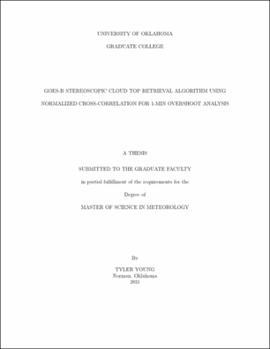| dc.contributor.advisor | Homeyer, Cameron | |
| dc.contributor.author | Young, Tyler | |
| dc.date.accessioned | 2021-08-05T16:27:02Z | |
| dc.date.available | 2021-08-05T16:27:02Z | |
| dc.date.issued | 2021-08-05 | |
| dc.identifier.uri | https://hdl.handle.net/11244/330215 | |
| dc.description.abstract | Satellite-based cloud top height (CTH) analyses are instrumental in understanding storm dynamics which can be utilized for severe and tornado warnings. Currently, CTHs are derived using IR imagery which are subject to errors. Some assumptions used when determining CTHs solely from IR produce less reliable CTHs such as knowledge of cloud emissivity, ambient temperature, lapse rate, and that the cloud is in thermodynamic equilibrium which is least true around intense thunderstorms. A method proposed for obtaining more accurate CTHs is stereoscopy since it is dependent on geometric relationships. Stereoscopy is a scientific technique used to combine two images to enhance the illusion of depth. This technique can be applied to weather phenomena using visible or infrared satellite images to retrieve CTHs. GOES-16 and GOES-17 mesoscale sector scans are time synchronized and can be used to take images of the same field of view with different viewing points. Conducting stereoscopy on this data can ultimately determine an offset between the two GOES images which is proportional to the corresponding CTH. Previous stereoscopy studies to calculate CTHs using American satellites have been conducted on thunderstorms and hurricanes in the 1980’s and 1990’s. Since then, satellites have advanced and the spatial and temporal resolution of visible and infrared images from new-era GOES are now available at 0.5 km and 2 km resolution, respectively, every minute. It is hypothesized this increase in resolution will allow cloud height calculations accurate to within 500 m which is higher than the accuracy found in past studies of 1500 m. Retrieved CTHs are compared to echo top heights from GridRad to determine validity of the height estimate. The nature of analyzing storms through stereoscopy presents several constraints. Visible imagery from GOES constrains analyses to storms during the day. In addition, using GOES-16 and GOES-17 as the two satellites only allows for analyses of storms over the central U.S. since it is where both mesoscale floating domains overlap. These CTH analyses alongside radar data and storm reports can be used to further investigate severe storm dynamics. | en_US |
| dc.language | en_US | en_US |
| dc.subject | Stereoscopy | en_US |
| dc.subject | Satellite | en_US |
| dc.subject | Cloud Top Height | en_US |
| dc.title | GOES-R Stereoscopic Cloud Top Retrieval Algorithm Using Normalized Cross-Correlation for 1-min Overshoot Analysis | en_US |
| dc.contributor.committeeMember | Kirstetter, Pierre | |
| dc.contributor.committeeMember | Calhoun, Kristin | |
| dc.date.manuscript | 2021-08-03 | |
| dc.thesis.degree | Master of Science in Meteorology | en_US |
| ou.group | College of Atmospheric and Geographic Sciences::School of Meteorology | en_US |
